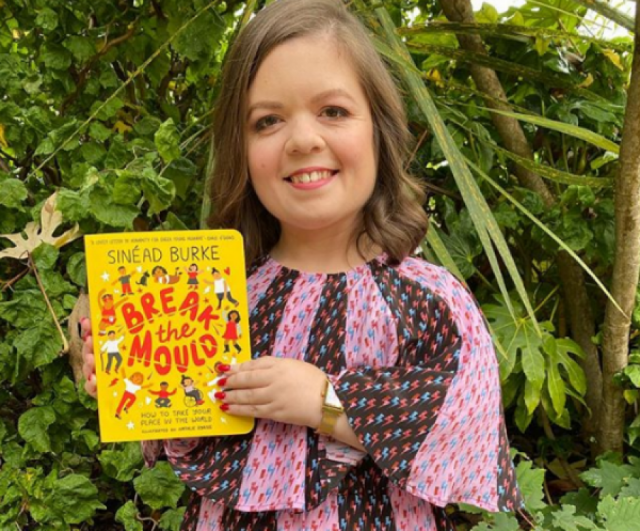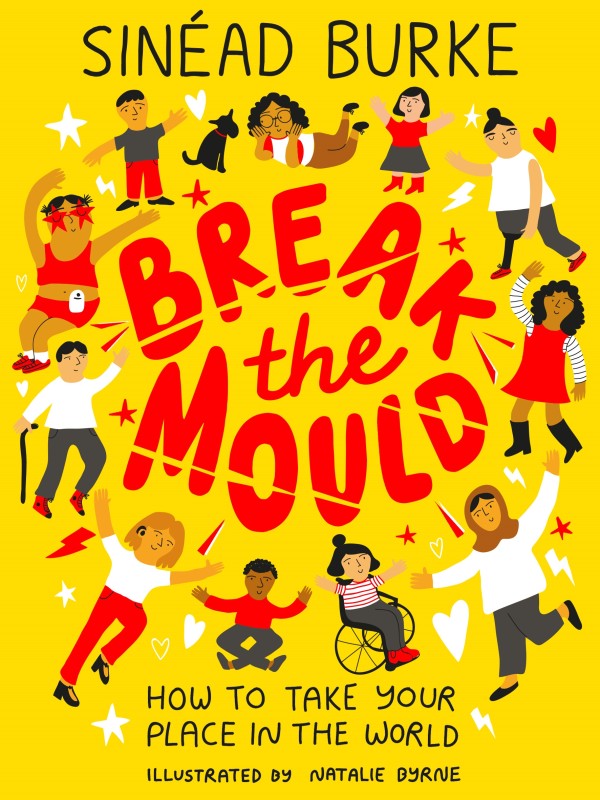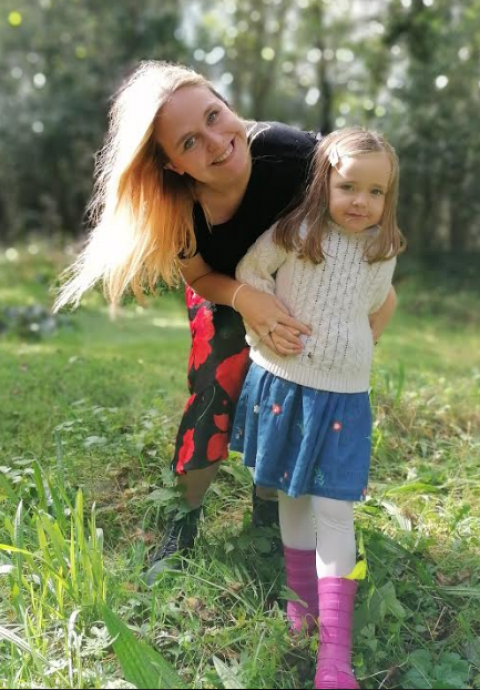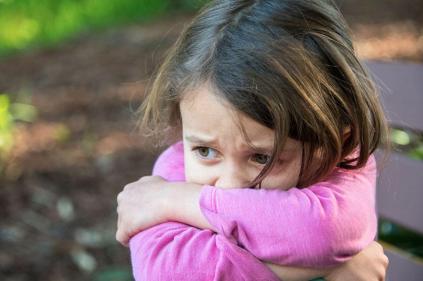I have been following Sinéad Burke for the last few years and have been in awe of her achievements.
At only 30 years of age, Sinéad’s CV reads like a bucket list - one that has already been completed. Her accomplishments are endless. She is a teacher, a writer, a fashion icon and an activist. She was the first little person to feature on the cover of Vogue magazine and to walk the red carpet at the Met Gala. She delivered a TED Talk, introduced the word 'duine beag' (meaning little person) into the Irish language and is a member of the Council of State, a body that advises the President of Ireland. These are just a few of the ways Sinéad has left her mark on the world. Her latest endeavour has been a swift flight to the top of the best sellers list after writing a beautiful new children’s book.
I spent the weekend reading Break the Mould to my six-year-old daughter. Needless to say, I was thrilled to have the opportunity to interview someone who has been breaking the mould for some time now. Though this book can be found amongst other brightly-colored children’s titles, I quickly realised that Break the Mould was not just for kids. It is a book for everyone.
Breaking the mould from an early age
When I asked what inspired her to write a children's book, Sinéad gave many reasons. Among them was the idea of representation. When Sinéad started school, she tells me, there were no books on the shelves that featured characters who looked like her. As a little person, she realised that so many aspects of the world were not designed for her and she decided to change that. Break the Mould is about encouraging our children to do the same - to redesign the world with inclusivity in mind.
Her very first day of school is central to Sinéad’s story and has shaped her into the influential person she is today. Little Sinéad introduced herself to her peers by spelling out her disability, in a manner far too articulate for any four-year-old. ‘I have achondroplasia’ she told the other junior infants and assured them that she could do anything they could do.
As a parent, Sinéad’s words resonate and I cannot help but feel the pride her mum and dad must have felt that day. When I ask Sinéad about her parents, her voice changes from teacher to tender and her unwavering respect for them becomes obvious. Her father is a little person, and her mother is of average height. Together they voluntarily set up Little People of Ireland, an organization that has brought families together from all over the country to discuss everything from education access to advice on where to buy shoes that fit. Sinéad attributes her success to the support her parents gave her. ‘My mother was an advocate for me before I could advocate for myself. If I am a success, it is because I was a loved child’.
Sinéad recounts a deeply personal story about the time her parents gave her the option to have limb-lengthening surgery. At just 11 years old, Sinéad turned down the opportunity to have this surgery for one simple reason: she wanted to continue being herself. Any ‘pros’ on her ‘pros and cons list’ (If you read her book you will see how much Sinéad loves lists) were outweighed by her desire to remain her true self.
‘As I began to contemplate it more, the biggest rationale for undertaking the surgery was not about reaching things. It was about fitting in it. If I got the surgery, I might be able to reach light switches or turn the shower on myself. I wouldn't have to ask for help anymore, but I would be changing who I was’.
Teaching parents the value of curiosity
I tell Sinéad that my favorite chapter in her book is the one about curiosity. As Sinéad knows all too well, children are born beautifully curious. ‘We know the value of curiosity but sometimes when it manifests in person, we shy away from it’. She describes herself as often being the ‘source’ of this curiosity. The example she gives me is one that every parent has seen in action. Sinéad sets the scene in a supermarket. A child notices her and tells mum or dad that they see her:
‘The parent’s instinctive reaction is to quieten the child, to distract them. The parent is mortified and tries not to embarrass me further. They think this is the first time this has ever happened to me.’ We can all admit to handling similar situations in this way. However, Sinéad assures me that she is most comfortable when a parent acknowledges her and allows their child to say ‘Hi’ and ask her about being a little person.
Sinéad has been privy to the curious minds of children from years of teaching and this is clear in the book. Every once in a while, she'll come across the student who asks her why she is so small and Sinéad answers them: ‘well, why are you so big?’ Their answers are the same: both Sinéad and her student were born that way. Sinéad tells me that children are usually more than happy with this answer and move on to more important things like asking what page the class is on.
Design in all its forms is especially important to Sinéad
In her book, she tells readers about the time she delivered a TED Talk on inclusivity within the fashion industry. She also had a plaster cast of her body made to create the first mannequin of a little person and collaborated with Lottie Dolls to create the first little person doll.
According to Sinéad, fashion is not the only industry that needs an overhaul. In the book she encourages her young readers to design the world anew in a way that facilitates people of all shapes and sizes - an accessible world. Sinéad tells me that in many ways she feels connected to children because they face the same struggles in terms of accessibility. ‘I am not disabled because I have dwarfism, I’m disabled because I can't reach the light switch. So much of the world isn't designed for me and that is why I'm disabled’.
Think about your experience as a parent in any public bathroom, hoisting your child up to wash their hands or standing outside their cubicle because you know they can't reach the lock. These are the struggles that Sinéad faces every day as an adult, as do many others in the disabled community. In her book Sinéad hands the torch to our children, to be the architects of an accessible world.
Language as a tool
Sinéad has met some incredibly influential people on her journey and has been in rooms where very few little people have been before. Though her achievements bring the word ‘powerhouse’ to mind, Sinéad tells me that still today, she experiences difficult situations where people make her feel uncomfortable and unsafe. ‘This week I was walking home, and two young people were following me, just being a bit intimidating, taking photos and laughing. Even then, at thirty years of age my natural reaction was to ring my mother’.
Sinéad encourages us to arm our children with information and language so they can use their voice and reach out for support when they find themselves in these situations. In Break the Mould she offers sample scripts of what to say when children (or adults) use words that make others feel uncomfortable or unsafe. This is part of a wider conversation on identity politics, something Sinead is passionate about. She encourages us to inform ourselves on what behaviour and language is outdated and hurtful within the inclusive world we are trying to build for our children.
A teacher by trade
The first time I became aware of Sinéad Burke’s activism I remember thinking how amazing it would be if my daughter could have a teacher like Sinéad. The way she delivers her crucial messages is one in a million. Her kindness, wisdom and patience come across beautifully both in person and in her new book. Break the Mould gives us all the opportunity to be taught by Sinéad. It is the toolkit we all need to make the world a better place.
The gorgeously quirky illustrations in this book were created by London based Latina illustrator, Natalie Byrne. Natalie is known for using bright colours to convey important social issues, making her and Sinéad the perfect pair. Break the Mould is published by Wren and Rook and is out now in all book shops across the country.
Featured image by Sara Freund






